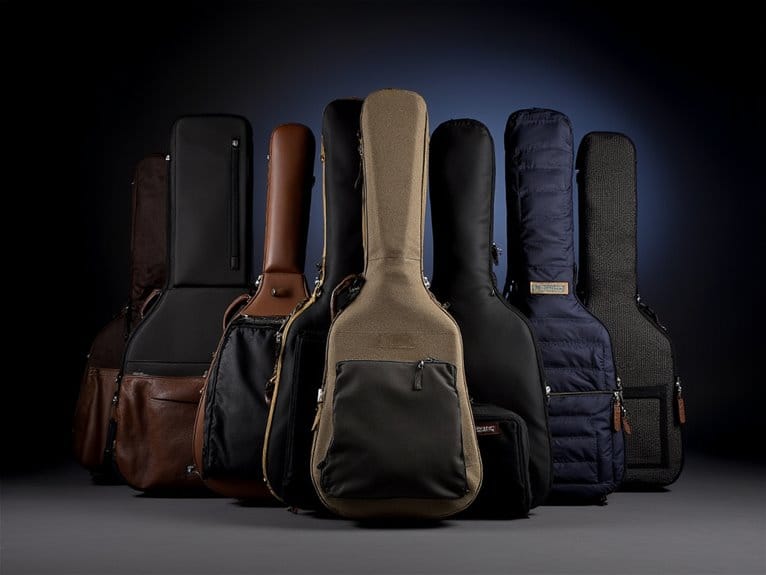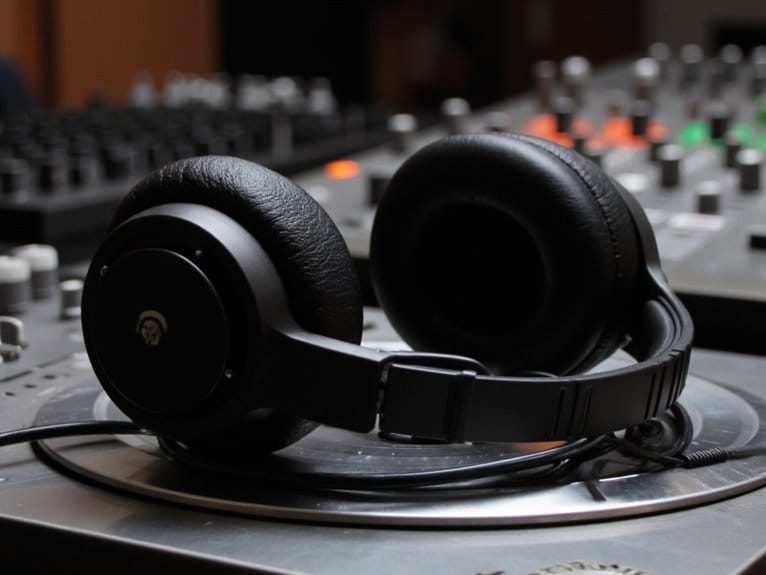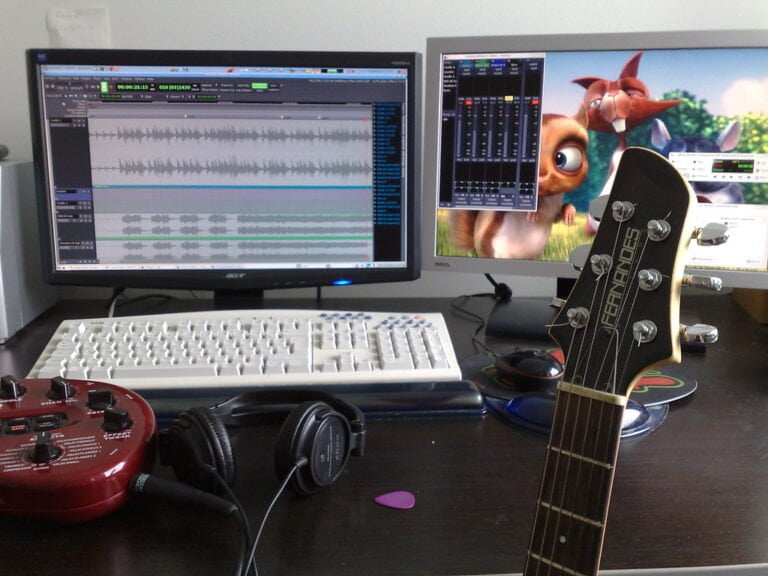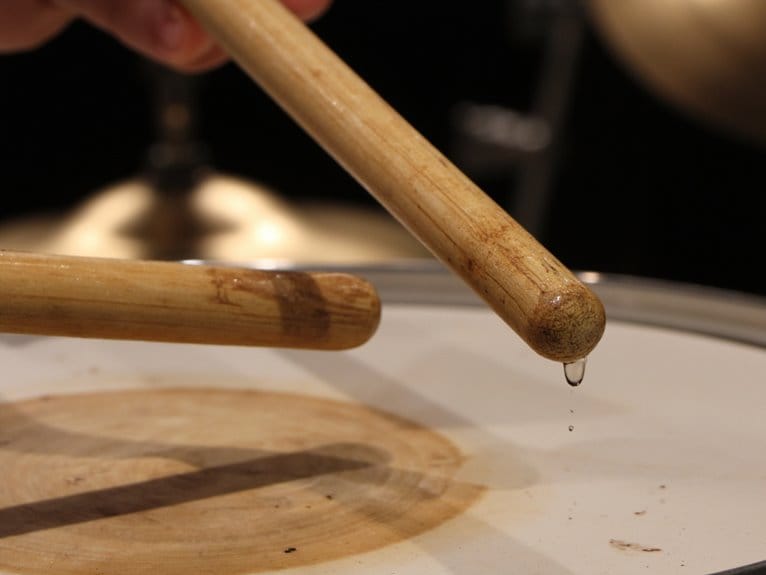Bass Guitar Amp Vs Direct Recording: Pros and Cons
You’ll find that direct recording offers cleaner tones and budget-friendly setups under $200, while bass amps provide natural harmonic saturation and character that’s harder to replicate digitally. Direct input gives you maximum post-production flexibility and consistent results regardless of room acoustics, but amps deliver the powerful stage presence and authentic feel that many bassists crave for live performances. Your choice ultimately depends on whether you prioritize studio versatility or that unmistakable amp warmth, though the complete picture involves several nuanced considerations.
We are supported by our audience. When you purchase through links on our site, we may earn an affiliate commission, at no extra cost for you. Learn more.
Notable Insights
- Direct recording requires minimal gear and lower costs, while amp setups need expensive amplifiers, cabinets, and ongoing maintenance.
- DI recording produces cleaner, defined tones with post-production flexibility, whereas amps provide natural harmonic saturation and character.
- Direct recording delivers consistent results regardless of room acoustics, while amp recording requires proper acoustic treatment and isolation.
- DI signals offer extensive tonal customization and re-amping options in post-production compared to fixed amp recordings.
- Direct setups are lightweight and portable, but amps provide better stage volume and monitoring for live performances.
Cost and Equipment Requirements
When you’re deciding between bass amp recording and direct input methods, the initial financial commitment represents one of the most crucial factors that’ll influence your choice.
Direct recording requires minimal gear—just your bass, cable, and audio interface—while amp setups demand amplifier heads, cabinets, microphones, and stands, often costing thousands more.
Direct recording keeps costs minimal with basic gear while amp setups require expensive amplifiers, cabinets, microphones, and stands.
I’ve found that budget considerations extend beyond initial purchases, since amp systems need regular maintenance on tubes, speakers, and electronics, whereas DI boxes rarely require servicing. Regular cleaning and maintenance of your recording equipment helps ensure optimal performance and extends the lifespan of your gear, especially with protective cases for portable recording setups.
Equipment longevity favors direct recording too, as fewer components mean fewer potential failures.
Plus, you’ll expand your tonal palette through software plugins rather than purchasing additional amplifiers, making DI recording considerably more cost-effective long-term. Many affordable audio interfaces under $200 now offer professional-grade preamps that deliver exceptional sound quality for direct bass recording. When selecting an audio interface for direct bass recording, USB-powered devices offer the convenience of simplified setup without requiring additional power supplies. Interestingly, some solid-state bass amps are actually cheaper than dedicated Bass DI boxes like the Sansamp, proving that price doesn’t always determine the best recording solution. The cost-effective approach of direct recording can save you hundreds to thousands of dollars compared to traditional amp recording setups.
Sound Quality and Tonal Characteristics
Beyond the financial considerations, the sonic differences between amp recording and direct input represent the heart of this debate, where each method delivers distinctly different tonal characteristics that’ll fundamentally shape your bass sound.
When examining clarity comparison between these approaches, DI recording consistently produces cleaner, more defined tones by eliminating ambient noise and room coloration that microphones inevitably capture.
However, bass amps contribute essential tonal elements that DI simply can’t replicate naturally:
- Harmonic saturation and natural compression from tube circuits or speaker movement
- Midrange “growl” and warmth that defines many classic bass tones
- Physical air movement and cabinet resonance affecting low-end response
The tonal flexibility advantage clearly favors DI recording, since you’ll retain complete control over tone-shaping through amp simulators, effects, and re-amping techniques during post-production, while mic’d amp recordings lock you into specific sonic characteristics. Higher wattage amplifiers produce cleaner tones and better definition, which becomes crucial when considering whether to record with physical amps versus direct input methods. Additionally, DI recording typically captures lower frequencies more effectively than microphones, with quality DI boxes extending down to 12Hz compared to most bass microphones that only reach 20-45Hz. For home recording scenarios, 10-20 watt amps provide adequate sound quality without overwhelming smaller spaces. Different tube configurations can significantly affect the warmth and harmonic content of your recorded bass tone, with options like 6V6GT tubes delivering warmer characteristics compared to the brighter EL84 configurations.
Recording Environment Considerations
Your recording environment plays a pivotal role in determining whether amp recording or direct input will serve your bass tracks better, as the acoustic characteristics of your space can either enhance or sabotage your chosen recording method.
In smaller home studios, I’ve found that acoustic treatment becomes critical when using bass amps, since low frequencies accumulate in corners and create muddy recordings. Bass traps and diffusers help control these issues, but they require investment and space optimization.
Direct recording sidesteps these problems entirely, offering consistent results regardless of room acoustics. However, you’ll need proper noise isolation for amp recording to prevent bleed-through, while monitoring techniques must account for how your space affects what you’re hearing during tracking sessions.
Post-Production Flexibility and Options
While the recording method you choose considerably impacts your initial sound capture, I’ve discovered that the real magic often happens during post-production, where direct input recording consistently provides far more flexibility than amp-recorded tracks.
DI experimentation offers unmatched creative flexibility through its neutral foundation, allowing unlimited tonal customization without committing to specific amp characteristics during tracking. The isolation benefits become particularly valuable when applying mixing techniques like multiband compression and transient shaping to your bass signal.
Key advantages of DI post-production include:
- Re amping options that let you experiment with different amplifiers and effects chains after recording.
- Blending tracks capabilities when combining DI and amp signals for maximum punch and warmth.
- Sound shaping precision through clean, noise-free signals that respond better to EQ and dynamic processing.
Professional DI recording requires a quality audio interface with dedicated instrument inputs that prevent clipping and provide optimal signal levels for bass guitar tracking.
Professional Studio Practices and Hybrid Approaches
When I step into professional recording studios, I’ve consistently observed that the most experienced engineers rarely commit to a single recording approach. Instead, they implement hybrid methodologies that capture both direct input and miked amplifier signals simultaneously.
You’ll find they use high-impedance DI boxes (≥1MΩ) connected through “through” configurations, allowing simultaneous amp feeding and clean signal capture on separate tracks. This dual-tracking method provides incredible mixing techniques flexibility, where you can blend the DI’s pristine low-end definition with the amp’s natural tube warmth and speaker coloration.
The key lies in careful phase alignment between signals to prevent cancellation issues. Professional tonal blending during tracking, combined with strategic compression from vintage Fairchild or Pultec units, creates that polished studio sound while maintaining maximum post-production control.
Frequently Asked Questions
How Do DIfferent Bass Guitar Types Affect DI Versus Amp Recording Choices?
Your bass’s active pickups deliver hotter signals that excel in DI recording, while passive pickups often benefit from amp coloration. Consider your instrument’s tone shaping capabilities when choosing methods to optimize recording quality.
What Are the Best Beginner-Friendly Options for Home Bass Recording?
You’ll want a basic home studio setup starting with an audio interface like Focusrite Scarlett 2i2, plus headphones and a DAW. Budget considerations suggest spending $300-500 initially, prioritizing core components over expensive gear.
On a final note
You’ll find that both bass amp recording and direct input methods offer distinct advantages, and honestly, I’ve learned that the best approach often depends on your specific project needs, budget constraints, and available space. While amps provide that natural compression and harmonic saturation that many bassists crave, direct recording offers unmatched flexibility and convenience. You can’t really go wrong experimenting with both techniques to discover your preferred sound.







